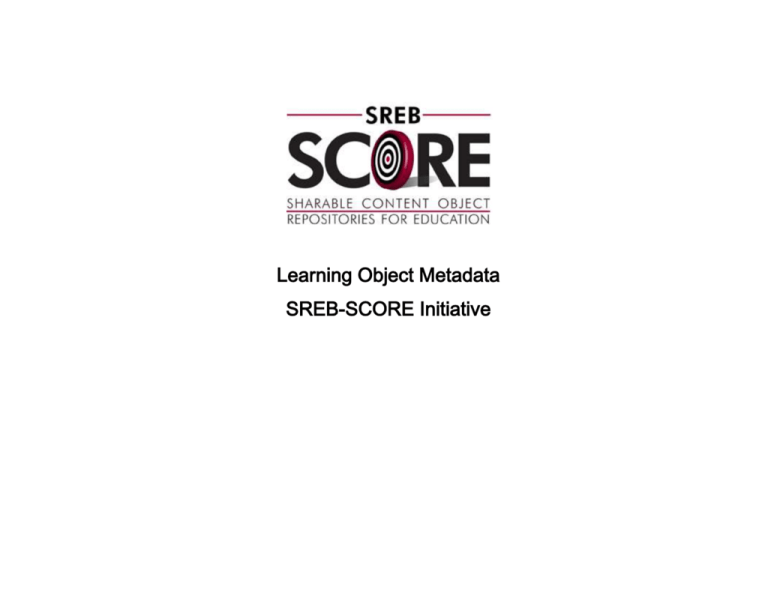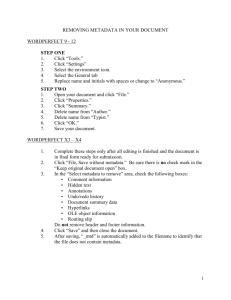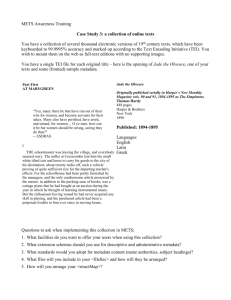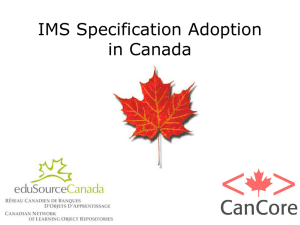
Learning Object Metadata
SREB-SCORE Initiative
2007
Southern Regional Education Board
592 10th St. N.W.
Atlanta, GA 30318
(404) 875-9211
© 2007 Southern Regional Education Board. Selected excerpts used with permission. All rights reserved. For more information, contact Bill Thomas,
director, SREB Educational Technology Cooperative, at (404) 875-9211 or bthomas@sreb.org.
Acknowledgements
It is always difficult to acknowledge the work of those involved in the development of a work of this kind without
inadvertently overlooking many others. While understanding this, we do want to thank several persons key to the
development of this SREB-SCORE document, including: Susan Henderson, associate executive director, Florida Distance
Learning Consortium; Cathy Alfano, project manager, The Orange Grove Digital Repository; Liz Glowa, K-12 instructional
consultant, SREB-SCORE Initiative; Priscilla Caplan, assistant director for Digital Library Services, Florida Center for
Library Automation, University of Florida; Judy Brown, former executive director, Academic ADL Co-Lab; Wil Hawk,
specialist, Maryland Virtual Learning Opportunities, Maryland State Department of Education; Marie Lasseter, project
manager, Learning Resource Management, University System of Georgia Board of Regents; June Weis, SREB research associate;
Rose Flynn, multimedia developer, Georgia Virtual Technical College; John Baker, president, Desire2Learn; and Bill
Thomas, director, SREB Educational Technology Cooperative.
Sources Used With Permission
Friesen, Norm. The CanCore Learning Resource Metadata Profile Guidelines. June 2002.
Friesen, Norm, Sue Fisher and Anthony Roberts. Guidelines for the Access For All Digital Resource Description, April 27, 2004.
Updated, March 24, 2006.
GEM Documentation. Gateway to 21st Century Skills, 2006.
IMS Meta-data Best Practice Guide for IEEE 1484.12.1— 2002 Standard for Learning Object Metadata; Version 1.3 Final
Specification © 2006 IMS Global Learning Consortium Inc. All rights reserved.
LOM metadata elements and controlled vocabulary are reprinted with permission from 1484.12.1 Learning Object Metadata
Standard, © 2002 IEEE. The IEEE disclaims any responsibility or liability resulting from the placement and use in the described
manner.
The LOM v1.0 graphic is an adaptation of the original graphic, Overview of LOM Draft 6.4, for LOM v1.0, prepared by Thomas
Hermann and used with permission. The SREB-SCORE version is taken from IMS Meta-data Best Practice Guide for IEEE
1484.12.1- 2002 Standard for Learning Object Metadata.
Table of Contents
Overview of LOM v1.0
6
Metadata Standards and Guidelines
7
Technical Standards
11
Definitions of Metadata and Learning Object
12
Digital Rights Management
13
LOM v1.0 Elements for the SREB-SCORE Initiative
14
Entering Metadata into LOM Fields
15
Table — LOM v1.0
16
Appendix A
General Element 1.8 — Aggregation Level (Granularity)
33
Appendix B
Educational Element 5.2 — Learning Resource Type
36
Appendix C
Classification Element 9.0: Explanations of Purpose, Source, Id and Entry
39
Classification Element 9.0: Subject Element GEM Controlled Vocabulary — Keywords
44
Classification Element 9.0: Other GEM Controlled Vocabularies – ERIC Thesaurus – Other
Authority Files — Keywords
51
Classification Element 9.0: Taxonomies Specific to SREB Member State Education Agencies
53
XML Examples for SREB-SCORE Learning Object Metadata
56
MERLOT XML Schema-instance (example)
68
Overview of LOM
This LOM graphic is an adaptation of the original graphic, Overview of LOM Draft 6.4, for LOM v1.0, prepared by Thomas Hermann and used with permission.
This SREB-SCORE version is taken from IMS Meta-data Best Practice Guide for IEEE 1484.12.1— 2002 Standard for Learning Object Metadata.
Metadata Standards and Guidelines
Web Sites That Describe and Define Metadata Standards
The standards and guides below serve as the basis for this SREB-SCORE initiative.
IMS Metadata Information Models
The IMS Global Learning Consortium provides a neutral forum in which members with
competing business interests and different decision-making criteria collaborate to satisfy
real-world requirements for interoperability and re-use. The IMS learning resource
metadata models have proceeded through eight releases from August 1999 to the IMS
Meta-data Best Practice Guide for IEEE 1484.12.1- 2002 Standard for Learning Object
Metadata, which was last revised in August 2006.
http://www.imsglobal.org
IMS Meta-data Best Practice Guide
for IEEE 1484.12.1-2002 Standard
for Learning Object Metadata:
Version 1.3; Final Specification
IMS Meta-data Best Practice Guide for IEEE 1484.12.1- 2002 Standard for Learning
Object Metadata (Version 1.3; Final Specification) was approved in August 2006. This
best practice and implementation guide provides a narrative description of the data model
along with guidelines on its use, including the creation of application profiles. It also
provides a brief description of IEEE P1484.12.3 Standard for Extensible Markup
Language (XML) Schema and other components, August 2006.
As of the issuance of this Learning Object Metadata SREB-SCORE Initiative document , this is the
latest specification for LOM v1.3. Used with permission in this SREB-SCORE document. © 2006
IMS Global Learning Consortium. All rights reserved.
IMS Meta-data Best Practice Guide for IEEE 1484.12.1— 2002 Standard for Learning Object
Metadata . IMS Global Learning Consortium. 2006 (Accessed January 3, 2007.)
http://www.imsproject.org/metadata/mdv1p3/imsmd_bestv1p3.html
IEEE: WG12: Learning Object
Metadata
This LOM v1.0 standard (precedes LOM 2002) specifies the syntax and semantics of
learning object metadata, defined as the attributes required to fully and adequately describe
a learning object.
The components are:
1484.12.1™: IEEE Standard for Learning Object Metadata
1484.12.2™: Standard for ISO/IEC 11404 binding for Learning Object Metadata Data Model
1484.12.3™: Standard for Learning Technology-Extensible Markup Language (XML) Schema
Definition Language Binding for Learning Object Metadata
1484.12.4™: Standard for Resource Description Framework (RDF) binding for Learning Object
Metadata Data Model
http://ltsc.ieee.org/wg12/
1484.12.1™ IEEE Standard for
Learning Object Metadata (LOM)
1484.12.1™ IEEE Standard for Learning Object Metadata, September 2002, is sponsored
by the Learning Technology Standards Committee of the IEEE Computer Society and
approved by the American National Standards Institute (ANSI) and the IEEE-SA
Standards Board. Available for download-purchase. (Search for IEEE Standards and
Metadata on this page.)
Draft Standard for Learning Object Metadata (July 2002)
http://ltsc.ieee.org/wg12/files/LOM_1484_12_1_v1_Final_Draft.pdf
Dublin Core Metadata Initiative
The Dublin Core Metadata Initiative is an open forum engaged in the development of
interoperable online metadata standards that support a broad range of purposes and
business models.
http://dublincore.org/
Dublin Core Metadata Element Set,
Version 1.1
The Dublin Core Metadata Element Set, Version 1.1, a vocabulary of 15 properties for use
in resource description, has gone through a number of revisions since its earliest
beginning. This document, issued on December 18, 2006, provides ready reference for the
Dublin Core Metadata Element Set, Version 1.1.
Dublin Core Metadata Element Set, Version 1.1 Dublin Core Metadata Initiative (DCMI). 2006.
(Accessed January 3, 2007.)
http://dublincore.org/documents/dces/
For more detailed documentation and links to historical versioning information, see the document
"DCMI Metadata Terms"
http://dublincore.org/documents/dcmi-terms/
Gateway to Educational Materials
(GEM)
GEM has developed a set of standards used worldwide for describing educational
resources on the Web, as well as tools to make creating resource descriptions simple.
These GEM standards and tools have been implemented in this SREB-SCORE document.
GEM Documentation. Gateway to 21st Century Skills. (Accessed January 3, 2007.)
http://www.thegateway.org/about/documentation.
Resource Description Framework
(RDF)
The Resource Description Framework (RDF) integrates a variety of applications from
library catalogs and worldwide directories to syndication and aggregation of news,
software and content to personal collections of music, photos and events using XML as
interchange syntax. The RDF specifications provide a lightweight ontology system to
support the exchange of knowledge on the Web.
Resource Description Framework (RDF) (Accessed October 29, 2007.)
http://www.w3.org/RDF/.
Resource Description Framework RDF metadata schemas in XML used by GEM in producing
descriptions of educational resources are described here. The various metadata schemas are
Resource Description Framework
(RDF) (cont’d.)
combined into an application profile
CanCore
CanCore is the official home for documents, presentations and other resources related to
the CanCore Learning Resource Metadata Initiative. CanCore enhances the ability of
educators, researchers and students in Canada and around the world to search and locate
material from online collections of educational resources. CanCore is based on and fully
compatible with the IEEE Learning Object Metadata standard and the IMS Learning
Resource Meta-data specification.
http://www.thegateway.org/about/documentation/schemas/
http://www.cancore.ca/en/
CanCore Initiative: CanCore
Learning Object Metadata
These guidelines provide comprehensive documentation on the CanCore Element Set and
are intended to help projects implement IMS metadata according to a common model and
in an effort to work towards an overarching community of practice.
http://www.cancore.ca/guidelines/CanCore%20Guidelines%20version%201.1.doc
The CanCore Learning Resource
Metadata Application Profile
Guidelines
CanCore Learning Object Metadata Application Profile Guidelines. Norm Friesen, June
2002.
CanCore Learning Object Metadata Application Profile Guidelines. (Accessed November. 28,
2006.)
http://www.cancore.ca/guidelines/
CanCore Guidelines for the Access
for all Digital Resource Description
CanCore Guidelines for the Access for All Digital Resource Description Metadata
Elements 2004. In this 2.0 document, these guidelines are synchronized with the IEEE
LOM v1.0 standard and include best practice recommendations for all LOM elements.
CanCore Guidelines for the Access
for all Digital Resource Description
(cont’d.)
CanCore Guidelines for the Access For All Digital Resource Description. Norm Friesen,
Sue Fisher, Anthony Roberts. April 2004. Updated March 2006.
CanCore Guidelines for the Access for all Digital Resource Description. (Accessed January 3,
2007.)
http://www.cancore.ca/en/guidelines.html
CanCore: Metadata for Learning
Objects
CanCore: Metadata for Learning Objects, by Norm Friesen, Anthony Roberts and Sue
Fisher. Canadian Journal of Learning and Technology, Vol. 28, Fall 2002
This paper describes the CanCore Learning Object Metadata Application Profile.
CanCore: Metadata for Learning Objects (Accessed January 3, 2006.)
http://www.cjlt.ca/content/vol28.3/friesen_etal.html
Technical Standards
Web Sites That Describe and Define Technical Standards
SCORM
Sharable Courseware Object
Reference Model
The SCORM 2004 3rd Edition Documentation is a collection and harmonization of
specifications and standards that define the interrelationship of content objects, data
models and protocols such that objects are sharable across systems that conform to the
same model.
http://www.adlnet.gov/scorm/20043ED/Documentation.aspx
What is SCORM? SCORM at a high-level is a collection of specifications and standards.
http://www.adlnet.gov/scorm/history/whatis.aspx
Two Minute SCORM Overview for
Developers
Basically there are two parts to SCORM Version 1.2: Run-Time Environment (RTE) and
Content Aggregation Model (CAM). This brief description of SCORM provides
definitions of important terms.
http://www.adlnet.gov/scorm/articles/article.aspx?id=1
Definitions of Metadata and Learning Objects
Web Sites That Describe and Define Metadata and Learning Objects
Academic Co-Lab Resources
A bibliography of resources regarding learning objects and repositories
http://www.academiccolab.org/resources/index.html
Crosswalks
A description of different metadata standards and how they relate to one another
http://www.oclc.org/research/projects/mswitch/1_crosswalks.htm
Learning Objects
Learning objects are defined by IEEE as any entity, digital or non-digital, which can be
used, re-used or referenced during technology-supported learning.
http://ltsc.ieee.org/wg12/
Learning objects as defined by SREB:
Learning objects are digital content that can be used and reused for teaching and
learning, and they possess other adaptable characteristics that extend many learning
activities. (Principles of Effective Learning Objects, SREB, 2005)
Metadata
Metadata is defined as the information about a digital object that enables it to be retrieved
from a database. It is information about the learning object rather than information in the
learning object. J. Paul Getty Trust
http://www.getty.edu/research/conducting_research/standards/intrometadata/index.html
Data about other data, commonly divided into descriptive metadata such as bibliographic
information, structural metadata about formats and structures, and administrative
metadata, which is used to manage information. The MIT Press 2000
http://www.cs.cornell.edu/wya/DigLib/MS1999/glossary.html
Digital Rights Management
Resources for Managing Intellectual Property Rights
Creative Commons
Creative Commons is a non-profit organization that provides tools for sharing, remixing
and reusing creative work legally. “Creative Commons defines the spectrum of
possibilities between full copyright — all rights reserved — and the public domain — no
rights reserved. Our licenses help you keep your copyright while inviting certain uses of
your work — a “some rights reserved” copyright.”
http://creativecommons.org/
“Get Creative” is a Flash movie that provides a visual explanation of how Creative
Commons works.
http://mirrors.creativecommons.org/getcreative/









